Impacts of the COVID-19 Pandemic on Business Operations
Impacts of the COVID-19 Pandemic on Business Operations
As part of the 2020 Annual Capital Expenditures Survey (ACES), questions were asked to gather information about the impact of the COVID-19 pandemic on business operations. The tables provide the sources of financial assistance requested/received by U.S. nonfarm employer businesses; use of the financial assistance received; impact on payroll and budgeted capital expenditures; and the use of capital expenditures to fund investments related to social distancing and safety. All data for companies with employees are available at the national level by 2-digit North American Industry Classification System (NAICS) industry sector. The tables also provide sources of financial assistance requested/received by companies without employees.
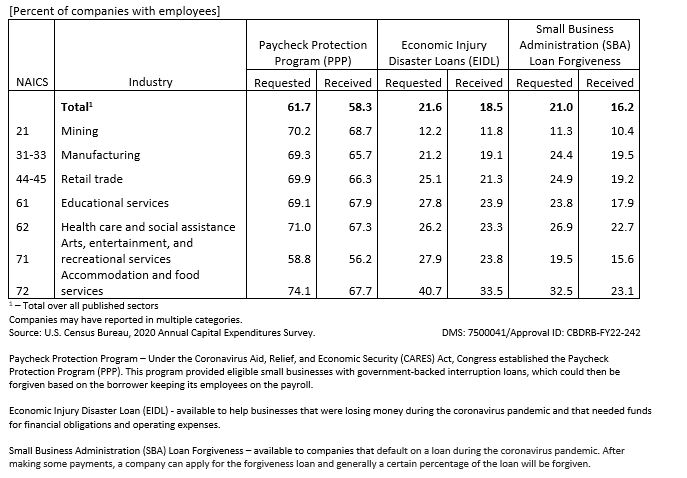
Financial assistance from the Paycheck Protection Program (PPP) was requested by 61.7 percent of companies with employees and received by 58.3 percent during the Coronavirus pandemic in 2020.
Sector highlights:
- Mining – Requested (70.2 percent) / Received (68.7 percent).
- Retail trade – Requested (69.9 percent) / Received (66.3 percent).
- Educational services – Requested (69.1 percent) / Received (67.9 percent).
- Accommodation and food services – Requested (74.1 percent) / Received (67.7 percent).
Financial assistance from the Economic Injury Disaster Loan (EIDL) was requested by 21.6 percent of companies with employees and received by 18.5 percent during the Coronavirus pandemic in 2020.
Sector highlights:
- Educational services – Requested (27.8 percent) / Received (23.9 percent).
- Health care and social assistance – Requested (26.2 percent) / Received (23.3 percent).
- Arts, entertainment, and recreational services – Requested (27.9 percent) / Received (23.8 percent).
- Accommodation and food services – Requested (40.7 percent) / Received (33.5 percent).
Financial assistance from the Small Business Administration (SBA) Forgiveness Loan program was requested by 21.0 percent of companies with employees and received by 16.2 percent during the coronavirus pandemic in 2020.
Sector highlights:
- Manufacturing – Requested (24.4 percent) / Received (19.5 percent).
- Retail trade – Requested (24.9 percent) / Received (19.2 percent).
- Health care and social assistance – Requested (26.9 percent) / Received (22.7 percent).
- Accommodation and food services – Requested (32.5 percent) / Received (23.1 percent).
Companies Receipt of Financial Assistance and Use of the Funds:
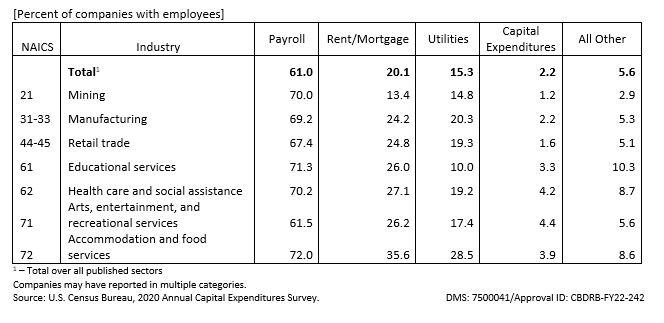
In 2020, 62.8 percent of companies with employees received financial assistance.
In 2020, 61.0 percent of companies with employees received financial assistance from one or more sources and used the funds to rehire or maintain employees on their payroll, 20.1 percent used the funds to pay the rent/mortgage, 15.3 percent to pay for utilities, 2.2 percent for capital expenditures, and 5.6 percent for all other expenses.
Sector highlights:
- Payroll - Mining (70.0 percent), Retail trade (67.4 percent); Educational services (71.3 percent), Health care and social assistance (70.2 percent); Accommodation and food services (72.0 percent).
- Rent/mortgage – Retail trade (24.8 percent); Educational services (26.0 percent); Healthcare and social assistance (27.1 percent); Arts, entertainment, and recreational services (26.2 percent); Accommodation and food services (35.6 percent).
- Utilities – Manufacturing (20.3 percent); Retail trade (19.3 percent); Healthcare and social assistance (19.2 percent), and Accommodation and food services (28.4 percent).
- Capital expenditures - Healthcare and social assistance sector (4.2 percent); Arts, entertainment, and recreational services (4.4 percent): Accommodation and food services (3.9 percent).
- All other expenses – Educational services (10.3 percent); and Health care and social assistance (8.7 percent).
Impact of Coronavirus Pandemic on Payroll:
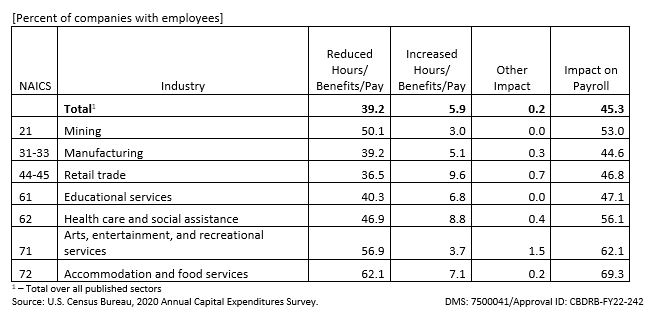
In 2020, the coronavirus pandemic impacted the payroll of 45.3 percent of companies with employees. This breaks down to 39.2 percent having reduced the hours/benefits/pay of their employees, 5.9 percent increased the hours/benefits/pay of their employees, and 0.2 percent saw a different impact on their payroll.
Sector highlights:
- Reduced the hours/benefits/pay - Mining (50.1 percent); Arts, entertainment, and recreational services (56.9 percent); Accommodation and food services (62.1 percent)
- Increased the hours/benefits/pay – Manufacturing (5.1 percent); Retail trade (9.6 percent); Health care and social assistance (8.8 percent); Accommodation and food services (7.1 percent)
Changes to Budgeted Capital Expenditures Due to the Coronavirus Pandemic:
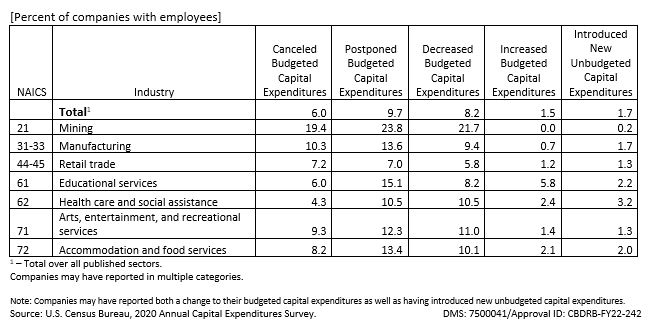
In 2020, 6.0 percent of companies canceled, 9.7 percent postponed, 8.2 percent decreased, and 1.5 increased some of their budgeted capital expenditures during the coronavirus pandemic. A total of 1.7 percent of companies introduced new unbudgeted capital expenditures.
Sector Highlights:
- Canceled budgeted capital expenditures – Mining (19.4 percent); Manufacturing (10.3 percent); Retail trade (7.2 percent); Arts, entertainment, and recreational services (9.3 percent); and Accommodation and food services (8.2 percent).
- Postponed budgeted capital expenditures - Mining (23.8 percent); Manufacturing (13.6 percent); Education services (15.1 percent); Arts, entertainment, and recreational services (12.3 percent); and Accommodation and food services (13.4 percent).
- Decreased budgeted capital expenditures – Mining (21.7 percent), Healthcare and social assistance (10.5 percent); Arts, entertainment, and recreational services (11.0 percent); and Accommodation and food services (10.1 percent).
- Increased budgeted capital expenditures - Educational services (5.8 percent); Healthcare and social assistance (2.4 percent); and Accommodation and food services (2.1 percent).
- Introduced new unbudgeted capital expenditures - Educational services (2.2 percent); Healthcare and social assistance (3.2 percent); and Accommodation and food services (2.0 percent).
Use of Capital Expenditures to Fund Investment Related to Social Distancing or Safety in Response to the Coronavirus Pandemic:
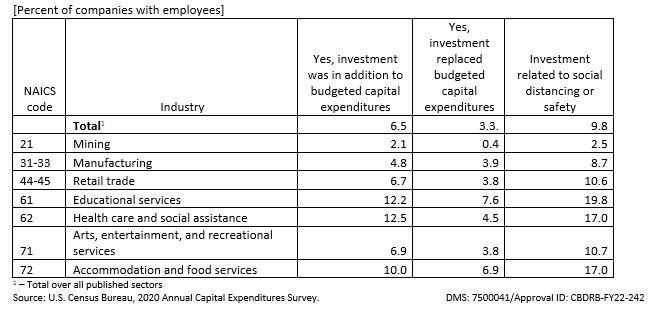
In 2020, 9.8 percent of the companies used capital expenditures to fund investment related to social distancing and safety.
Sector highlights:
- Retail trade (10.6 percent); Educational services (19.8 percent); Health care and social assistance (17.0 percent); Arts, entertainment, and recreational services (10.7 percent); and Accommodation and food services (17.0 percent).
- Of the 9.8 percent of companies using capital expenditures to fund investment related to social distancing and safety, 6.5 percent used capital expenditures above what they budgeted for 2020 and 3.8 percent replaced their budgeted capital expenditures to make the investment.
Sector highlights:
- Invested in addition to budgeted capital expenditures - Retail trade (6.7 percent); Educational services (12.2 percent); Health care and social assistance (12.5 percent); and Accommodation and food services (10.0 percent).
- Investment replaced budgeted capital expenditures – Educational services (7.6 percent); Health care and social assistance (4.5 percent); and Accommodation and food services (6.9 percent).
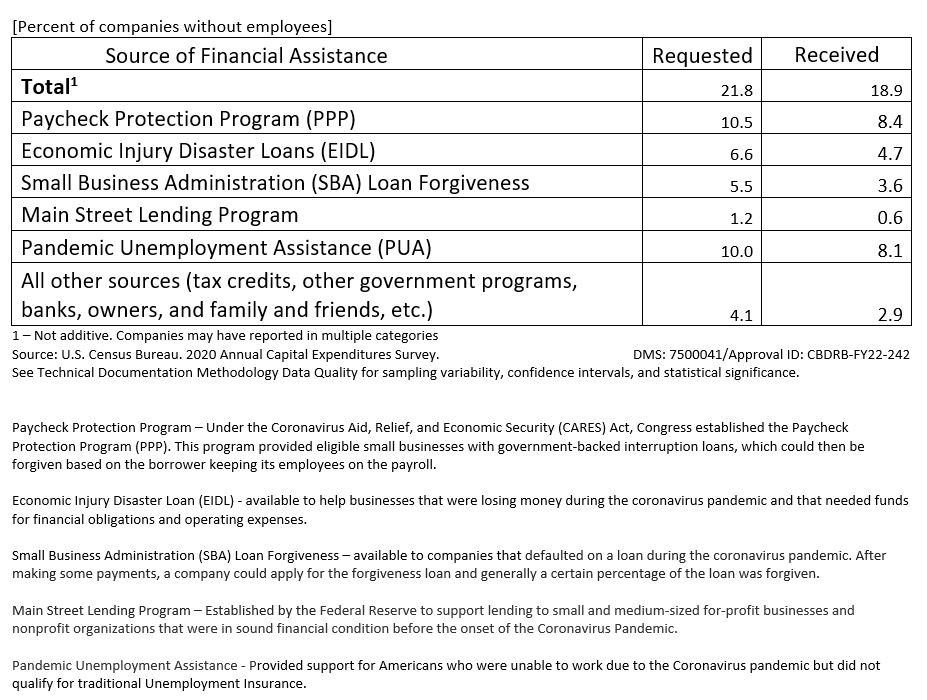
Financial assistance was requested by 21.8 percent of companies without employees and received by 18.9 percent during the Coronavirus pandemic in 2020.
Financial assistance from the Paycheck Protection Program (PPP) was requested by 10.5 percent of companies without employees and received by 8.4 percent during the Coronavirus pandemic in 2020.
Financial assistance from the Economic Injury Disaster Loan (EIDL) was requested by 6.6 percent of companies without employees and received by 4.7 percent during the Coronavirus pandemic in 2020.
Financial assistance from the Small Business Administration (SBA) Forgiveness Loan program was requested by 5.5 percent of companies without employees and received by 3.6 percent during the coronavirus pandemic in 2020.
Financial assistance from the Main Street Lending Program was requested by 1.2 percent of companies without employees and received by 0.6 percent during the coronavirus pandemic in 2020.
Financial assistance from the Pandemic Unemployment Assistance program was requested by 10.0 percent of companies without employees and received by 8.1 percent during the coronavirus pandemic in 2020.
Financial assistance from All other sources (tax credits, other government programs, banks, owners, and family and friends, etc.) was requested by 4.1 percent of companies without employees and received by 2.9 percent during the coronavirus pandemic in 2020.







